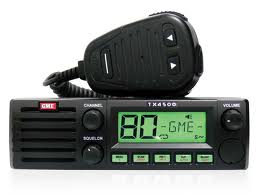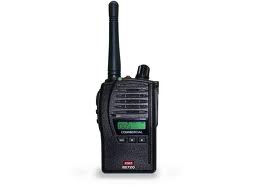UHF CB uses the FM transmission mode. UHF gives clear, crisp local communication without the long-distance interference sometimes heard on 27 MHz. UHF is also less susceptible to power line noise than 27 MHz. Its main disadvantage is that it performs poorly in hilly and forested areas due to its 'line of sight' characteristics. Typical direct (simplex) car-to-car ranges of UHF vary between about 5 kilometers in urban areas to 20 kilometers or more in open countryside. However if located on a hilltop, distances of 50 kilometers are common, even with low-powered handheld equipment. UHF really comes into its own when repeater stations are used. Repeaters are installed on hilltops and retransmit signals received on one channel onto another channel. They are set up by community groups or commercial organisations but can freely be used by everyone. Distances of 50 to 100 kilometres are commonly achieved via repeaters, even if mobile or handheld transceivers are used. Most urban and rural areas are served by at least one repeater. To listen for the repeaters in your area, search for signals between channels 1 to 8 and 41 to 48. Those channels are busy most of the time are likely to be repeaters.
Note: as of June 2011 the ACMA has changed to rules for UHF CB to Allow 80 channel instead of the old 40 CH system, A 40 Channel CB will still work but audio from a 80 Channel will sound distorted on it, it is recommended that you use 80 channels were ever possible.
 UHF CB Mobile radio
UHF CB Mobile radio
 UHF CB Portable radio
UHF CB Portable radio
Repeaters
A Repeater Station picks up your signal on one Channel and retransmits it on another. Repeaters are located in very high positions and normally transmit high power. They typically have excellent radio range and can therefore greatly extend the radio coverage to their users, especially low power and mobile stations. Repeaters have a ‘time out’ to protect the repeater transmitter from damage should a fault or interference to its receiver lock it on. The time out varies typically from 3 minutes to 10 minutes. You should be aware of the timeout of repeater you are using as if you operate beyond the timeout period; the repeater will power down and the rest of your transmission will be lost. The timeout does not mean you cannot use the repeater for a longer period, it just your ‘over’, however it is good practice to keep you ‘overs’ short. You also need to leave a short break between ‘overs’ to reset the timer. Repeaters are a shared resource among radio operators; as usual you should always listen to see if a repeater is in use before you make a call. If you want to participate with a group currently using the repeater just wait for a pause in transmission and announce you wish to join in (using brake or breaker). Remember to leave breaks between ‘overs’ to allow other stations to call in
Click hear for more information about Repaters
Sellcall
Sellcall is a system that operates like a telephone; the radio is programmed with its own unique Selcall identification number. If this number is called by another radio your radio will beep to alert you. If you do not whish to hear any other activity while waiting on a channel, you can activate a quiet mode; the radio will then remain quiet to all incoming signals until your Selcall number is called this system can be used as a paging system or a way minimise traffic on a channel the down side of this is that all Sellcall numbers must be known to the user and every one using it must no ho to operate their radios correctly. Sellcall is a digital mode and can be used on channels 22 and 21, try and avoid calling mutable times as the digital traffic can be irritating to other users. The main use for Sellcall is for remote control systems it is very popular with farmers as a way to turn water pumps on and off, open close gates and so on farms
Click hear for more information about Sellcall
CTCSS
CTCSS (Continuous Tone Coded Squelch System) is a Squelch quieting system that allows several groups of users to share the same channel without disturbing each other. It uses one of 50 preset sub-audible (very low frequency) tones to open and close the squelch on your radio. The system applies a continuous low-level tone decoder to your receiver’s squelch. With CTCSS enabled, the channel remains quiet to all incoming signals unless they carry the correct tone. When a transmission with the correct tone is received, the squelch opens and remains open for as long as the signal is present. When the channel becomes quiet again transmissions that do not use the correct tone will not be heard
Click hear for more information about CTCSS
| Pros |
Cons |
| Licence Free |
Public Service |
| Repeaters Available |
Rage over 20 Km not possible without repeater |
| Low level Security functions |
Will not work throw heavy bush or in valleys |
| Low cost |
Can become congested in city’s |
| Easy to find |
|
UHF CB Channels
| Channel |
Uses |
| 1 |
Repeater 1 Output |
| 2 |
Repeater 2 Output |
| 3 |
Repeater 3 Output |
| 4 |
Repeater 4 Output |
| 5 |
Emergency /Emergency Repeater output |
| 6 |
Repeater 6 Output |
| 7 |
Repeater 7 Output |
| 8 |
Repeater 8 Output |
| 9 |
Conversations |
| 10 |
4Wdrivers |
| 11 |
Calling |
| 12 |
Conversations |
| 13 |
Conversations |
| 14 |
Conversations |
| 15 |
Conversations |
| 16 |
Conversations |
| 17 |
Conversations |
| 18 |
Caravan's, campers |
| 19 |
Conversations |
| 20 |
Conversations |
| 21 |
Digital (Telemetry and Selcall) |
| 22 |
Digital (Telemetry and Selcall) |
| 23 |
Conversations |
| 24 |
Conversations |
| 25 |
Conversations |
| 26 |
Conversations |
| 27 |
Conversations |
| 28 |
Conversations |
| 29 |
Conversations |
| 30 |
Broadcasts |
| 31 |
Repeater 1 Input |
| 32 |
Repeater 2 Input |
| 33 |
Repeater 3 Input |
| 34 |
Repeater 4 Input |
| 35 |
Emergency /Emergency Repeater input |
| 36 |
Repeater 6 Input |
| 37 |
Repeater 7 Input |
| 38 |
Repeater 8 Input |
| 39 |
Conversations |
| 40 |
Highway Communicans |
| 41 |
Repeater 41 Output |
| 42 |
Repeater 42 Output |
| 43 |
Repeater 43 Output |
| 44 |
Repeater 44 Output |
| 45 |
Repeater 45 Output |
| 46 |
Repeater 46 Output |
| 47 |
Repeater 47 Output |
| 48 |
Repeater 48 Output |
| 49 |
Conversations |
| 50 |
Conversations |
| 51 |
Conversations |
| 52 |
Conversations |
| 53 |
Conversations |
| 54 |
Conversations |
| 55 |
Conversations |
| 56 |
Conversations |
| 57 |
Conversations |
| 58 |
Conversations |
| 59 |
Conversations |
| 60 |
Conversations |
| 64 |
Conversations |
| 65 |
Conversations |
| 66 |
Conversations |
| 67 |
Conversations |
| 68 |
Conversations |
| 69 |
Conversations |
| 70 |
Conversations |
| 71 |
Repeater 41 Input |
| 72 |
Repeater 42 Input |
| 73 |
Repeater 43 Input |
| 74 |
Repeater 44 Input |
| 75 |
Repeater 45 Input |
| 76 |
Repeater 46 Input |
| 77 |
Repeater 47 Input |
| 78 |
Repeater 48 Input |
| 79 |
Conversations |
| 80 |
Conversations |

Emergency Situations
To call for help simply follow this procedure:
1. Select the emergency channel on your CB - Channel 5 (same on 40 & 80 Channel radios) (select 'Duplex' or 'Repeater' mode if in range of a channel 5/35 emergency repeater, otherwise use 'Simplex' mode - i.e. turn your Repeater or Duplex button OFF). Be aware some emergency Monitors may monitor other local UHF repeaters in addition to, or instead of, the emergency repeater. If no response is received, try other local channels.
2. Call "Any emergency monitor", this is "call sign or first name" calling any emergency monitor"
3. Give the Monitor time to answer if no response is received call again.
4. Respond with the nature of the incident, exact location and other information. The Monitor will ask you for the information that he/she needs in order to notify the required services.
Remember To Stay Calm!